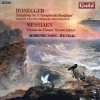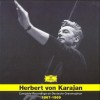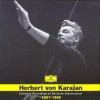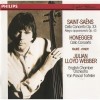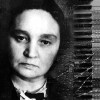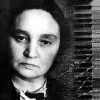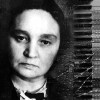Composers
Arthur Honegger (10 March 1892 – 27 November 1955) was a Swiss composer, who was born in France and lived a large part of his life in Paris. He was a member of Les six. His most frequently performed work is probably the orchestral work Pacific 231, which is interpreted as imitating the sound of a steam locomotive.
Born Oscar-Arthur Honegger (the first name was never used) in Le Havre, France, he initially studied harmony and violin in Paris, and after a brief period in Zurich, returned there to study with Charles-Marie Widor and Vincent d'Indy. He continued to study through the 1910s, before writing the ballet Le dit des jeux du monde in 1918, generally considered to be his first characteristic work. In 1926 he married Andrée Vaurabourg, a pianist and fellow student at the Paris Conservatoire, on the condition that they live in separate apartments. They lived apart for the duration of their marriage, with the exceptions of an attempt at living together in 1935, which lasted less than a year, and the last year of Honegger's life, when he could no longer live alone. They had one daughter, Pascale, born in 1932. Honegger also had a son, Jean-Claude (1926–2003), with the singer Claire Croiza.
In the early 1920s Honegger shot to fame with his "dramatic psalm" Le roi David ("King David"), which is still in the choral repertoire. Between World War I and World War II, Honegger was very prolific. He composed the music for Abel Gance's epic 1927 film, Napoléon. He composed nine ballets and three vocal stage works, amongst other works. One of those stage works, Jeanne d'Arc au bûcher (1935), a "dramatic oratorio" (to words by Paul Claudel), is thought of as one of his finest works. In addition to his pieces written alone, he collaborated with Jacques Ibert on both an opera, L'Aiglon (1937), and an operetta. During this time period he also wrote Danse de la chèvre (1921), an essential piece of flute repertoire. Dedicated to René Le Roy and written for flute alone, this piece is lively and charming, but with the same directness of all Honegger's work.
Honegger had always remained in touch with Switzerland, his parents' country of origin, but with the outbreak of the war and the invasion of the Nazis, he found himself unable to leave Paris. He joined the French Resistance and was generally unaffected by the Nazis themselves, who allowed him to continue his work without too much interference. However, he was greatly depressed by the war. Between its outbreak and his death, he wrote his last four symphonies (numbers two to five) which are among the most powerful symphonic works of the 20th century. Of these, the second, for strings, featuring a solo trumpet which plays a chorale tune by Johann Sebastian Bach in the final movement, and the third, subtitled Symphonie Liturgique with its three movements evoking the Requiem Mass (Dies Irae, De profundis clamavi and Dona nobis pacem), are probably the best known. Written in 1946 just after the end of the war, it has parallels with Benjamin Britten's Sinfonia da Requiem of 1940. In complete contrast with this work is the lyrical, nostalgic Symphony No. 4, subtitled "Deliciae Basilienses" ("The Delights of Basel") and written as a tribute to days of relaxation spent in that Swiss city during the war.
Honegger was widely known as a train enthusiast, and once notably said: "I have always loved locomotives passionately. For me they are living creatures and I love them as others love women or horses." His "mouvement symphonique" Pacific 231 (a depiction of a steam locomotive) gained him early notoriety in 1923.
Many of Honegger's works were championed by his long time friend Georges Tzipine, who conducted the premiere recordings of some of them (Cris du Monde oratorio, Nicolas de Flüe).[1]
In 1953 he wrote his last composition, A Christmas Cantata. After a protracted illness, he died at home of a heart attack on 27 November 1955 and was interred in the Saint-Vincent Cemetery in the Montmartre Quarter of Paris.
The principal elements of Honegger's style are: Bachian counterpoint, driving rhythms, melodic amplitude, highly coloristic harmonies, an impressionistic use of orchestral sonorities, and a concern for formal architecture. His style is weightier and more solemn than that of his colleagues in Les six. Far from reacting against German romanticism as the other members of Les six did, Honegger's mature works show evidence of a distinct influence by it. Despite the differences in their styles, he and fellow Les six member Darius Milhaud were close friends, having studied together at the Paris Conservatoire. Milhaud dedicated his fourth string quintet to Honegger's memory, while Francis Poulenc similarly dedicated his Clarinet Sonata.
Honegger is currently featured on the Swiss twenty franc banknote.
Recently Added
Honegger - Pastorale d'ete; Symphony No.4; Une Cantate de Noel - Vladimir Jurowski, Christopher Maltman, London Philharmonic Orchestra and Choir
Biography
Arthur Honegger (10 March 1892 – 27 November 1955) was a Swiss composer, who was born in France and lived a large part of his life in Paris. He was a member of Les six. His most frequently performed work is probably the orchestral work Pacific 231, which is interpreted as imitating the sound of a steam locomotive.
Born Oscar-Arthur Honegger (the first name was never used) in Le Havre, France, he initially studied harmony and violin in Paris, and after a brief period in Zurich, returned there to study with Charles-Marie Widor and Vincent d'Indy. He continued to study through the 1910s, before writing the ballet Le dit des jeux du monde in 1918, generally considered to be his first characteristic work. In 1926 he married Andrée Vaurabourg, a pianist and fellow student at the Paris Conservatoire, on the condition that they live in separate apartments. They lived apart for the duration of their marriage, with the exceptions of an attempt at living together in 1935, which lasted less than a year, and the last year of Honegger's life, when he could no longer live alone. They had one daughter, Pascale, born in 1932. Honegger also had a son, Jean-Claude (1926–2003), with the singer Claire Croiza.
In the early 1920s Honegger shot to fame with his "dramatic psalm" Le roi David ("King David"), which is still in the choral repertoire. Between World War I and World War II, Honegger was very prolific. He composed the music for Abel Gance's epic 1927 film, Napoléon. He composed nine ballets and three vocal stage works, amongst other works. One of those stage works, Jeanne d'Arc au bûcher (1935), a "dramatic oratorio" (to words by Paul Claudel), is thought of as one of his finest works. In addition to his pieces written alone, he collaborated with Jacques Ibert on both an opera, L'Aiglon (1937), and an operetta. During this time period he also wrote Danse de la chèvre (1921), an essential piece of flute repertoire. Dedicated to René Le Roy and written for flute alone, this piece is lively and charming, but with the same directness of all Honegger's work.
Honegger had always remained in touch with Switzerland, his parents' country of origin, but with the outbreak of the war and the invasion of the Nazis, he found himself unable to leave Paris. He joined the French Resistance and was generally unaffected by the Nazis themselves, who allowed him to continue his work without too much interference. However, he was greatly depressed by the war. Between its outbreak and his death, he wrote his last four symphonies (numbers two to five) which are among the most powerful symphonic works of the 20th century. Of these, the second, for strings, featuring a solo trumpet which plays a chorale tune by Johann Sebastian Bach in the final movement, and the third, subtitled Symphonie Liturgique with its three movements evoking the Requiem Mass (Dies Irae, De profundis clamavi and Dona nobis pacem), are probably the best known. Written in 1946 just after the end of the war, it has parallels with Benjamin Britten's Sinfonia da Requiem of 1940. In complete contrast with this work is the lyrical, nostalgic Symphony No. 4, subtitled "Deliciae Basilienses" ("The Delights of Basel") and written as a tribute to days of relaxation spent in that Swiss city during the war.
Honegger was widely known as a train enthusiast, and once notably said: "I have always loved locomotives passionately. For me they are living creatures and I love them as others love women or horses." His "mouvement symphonique" Pacific 231 (a depiction of a steam locomotive) gained him early notoriety in 1923.
Many of Honegger's works were championed by his long time friend Georges Tzipine, who conducted the premiere recordings of some of them (Cris du Monde oratorio, Nicolas de Flüe).[1]
In 1953 he wrote his last composition, A Christmas Cantata. After a protracted illness, he died at home of a heart attack on 27 November 1955 and was interred in the Saint-Vincent Cemetery in the Montmartre Quarter of Paris.
The principal elements of Honegger's style are: Bachian counterpoint, driving rhythms, melodic amplitude, highly coloristic harmonies, an impressionistic use of orchestral sonorities, and a concern for formal architecture. His style is weightier and more solemn than that of his colleagues in Les six. Far from reacting against German romanticism as the other members of Les six did, Honegger's mature works show evidence of a distinct influence by it. Despite the differences in their styles, he and fellow Les six member Darius Milhaud were close friends, having studied together at the Paris Conservatoire. Milhaud dedicated his fourth string quintet to Honegger's memory, while Francis Poulenc similarly dedicated his Clarinet Sonata.
Honegger is currently featured on the Swiss twenty franc banknote.

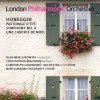
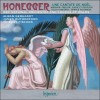
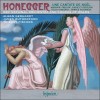



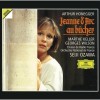
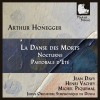
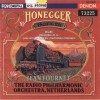


![Russian legends - Mstislav Rostropovich [10 CD]](http://static.classicalm.com/repository/collection-cover/small/275-img1319023256353734.jpg)
![Great European Organs. 36-Marie-Bernadette Dufourcet [Notre-Dame-des-Champs Paris]](http://static.classicalm.com/repository/collection-cover/small/911-img1341739496579533.jpg)

